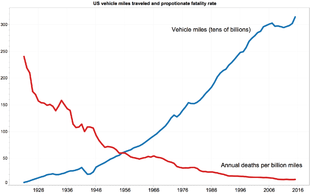Transportation safety in the United States

Transportation safety encompasses automobile accidents, airplane crashes, railroad and motorcoach fatalities and maimings, and other mass transit incidents. Safety overall has steadily improved in the United States for many decades. Between 1920 and 2000, the rate of fatal automobile accidents per vehicle-mile decreased by a factor of about 17.[1][2] Except for a pause during the youth bulge of the 1960s (a time when many young, inexperienced drivers were on the road), progress in reducing fatal accidents has been steady. Safety for other types of U.S. passenger transportation has also improved substantially, but long-term statistical data are not as readily available. While the fatality rate roughly leveled off around 2000–2005 at around 1.5 fatalities per 100 million miles traveled, it has resumed a downward trend and reached 1.27 in 2008.[1]
One can also calculate auto fatalities per driver's license. From 1990 to 2009, this number has also been declining: from 1 death per 3,745 driver's licenses in 1990 to 1 per 6,200 driver's licenses in 2009.[3] Crowded, traffic-choked Northeastern cities including, Washington, D.C., Baltimore, Boston, Providence, Philadelphia, Newark, Hartford, New Haven, Springfield and Worcester, Massachusetts were most likely to have car accidents.[4] The National Highway Traffic Safety Administration through its Fatality Analysis Reporting System stated that approximately 30,000 auto fatalities occur each year, and continue to be the leading cause of death for young adults.[5]
Following an approach used by several writers,[6][7] one can compare the likelihood of a fatal accident while driving and while flying with a scheduled airline. This is most meaningful for trips in which either mode of transportation is a reasonable alternative. In the United States, a typical trip of this sort is from the Boston area to the Washington, D.C. area, about 6 hours door-to-door by air travel and 7 hours door-to-door by automobile. To compare typical risks, one needs to have both driving and flying statistics expressed in comparable units. For driving, one can use the U.S. average fatal automobile fatality rate of 1.5 per 100 million vehicle-miles for 2000[1] and then translate it into passenger-miles (to get a single-person risk exposure). For flying, one can use a statistic such as the U.S. general and commercial aviation fatality rate, which was 1.9 per 100,000 flight hours for 2000,[8][9] which again needs to be expressed in passenger-miles (e.g., if an airplane has 180 passengers, then the passenger miles are 180 times higher, which translates into a considerably lower fatality risk on a per passenger basis; also, most travelers are concerned with the potential risk of passenger commercial airlines, which are significantly different from general aviation statistics, which include small non-commercial airplanes). The number of deaths per passenger-mile on commercial airlines in the United States between 1995 and 2000 was about 3 deaths per 10 billion passenger-miles.[10]
Many accidents when driving personal vehicles are caused by distracted driving. According to the American Auto Association (AAA), distraction plays a factor in 60% of moderate to serious teen car crashes. Specifically, passenger and cell phone interaction accounted for 27% of crashes, the leading cause. Drivers looking away from the target (roadway) also accounted for 19%.[11]
Rail and motorcoach accidents also account for fatalities, although public transportation is far less dangerous than driving a personal vehicle.
See also
- List of motorcycle deaths in U.S. by year
- Alcohol-related traffic crashes in the United States
- List of motor vehicle deaths in U.S. by year
- Car accident
- Road safety
- Air safety
- Risk analysis
- Rail Safety Improvement Act of 2008
- Work-related road safety in the United States
Notes
- 1 2 3 "Fatality Analysis Reporting System". U.S. National Highway Traffic Safety Administration.
- ↑ "Making Sense of Highway Data". U.S. National Motorists Association.
- ↑ "Table 1105. Fatal Motor Vehicle Accidents—National Summary: 1990 to 2009" (PDF). U.S. Census Bureau.
- ↑ Doyle, Rice (11 November 2014). "Northeastern Cities Have the Most Car Accidents". USA Today. Retrieved 12 May 2015.
- ↑ "NHTSA Data Confirms Traffic Fatalities Increased In 2012". U.S. Department of Transportation. National Highway Traffic Safety Administration. 14 November 2013. Retrieved 26 April 2015.
- ↑ Arnold Barnett (1991). "It's Safer to Fly". Risk Analysis. 11 (1): 13–14. doi:10.1111/j.1539-6924.1991.tb00558.x.
- ↑ Peter B. Ladkin (1997). "To Drive or To Fly". University of Bielefeld.
- ↑ Rathmann, Kimberly. "General Aviation – Accidents and Fatalities". Retrieved 15 November 2013.
- ↑ "Figure 1 – General Aviation Fatality Rates: 1975–2000". U.S. Department of Transportation. Retrieved 15 November 2013.
- ↑ "Aviation".
- ↑ Manookian, Brian. "Statistical Risks Of Driving And Related Acts". Cummings Manookian. Retrieved 2 October 2015.
References
- Badger, Emily; Ingraham, Christopher (October 1, 2015), "The hidden inequality of who dies in car crashes", The Washington Post